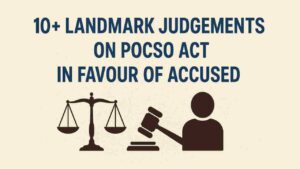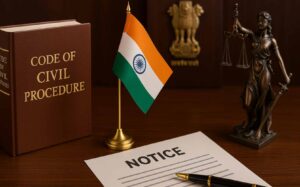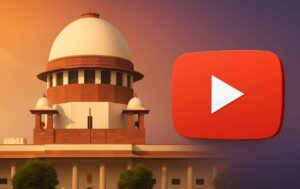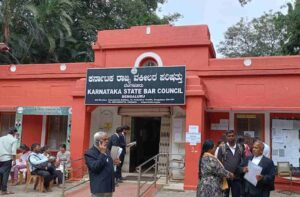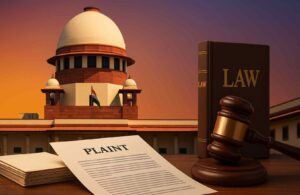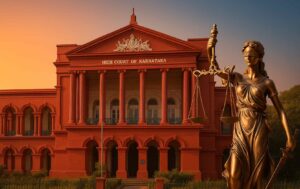Article 32 of the Indian Constitution is often described as the “heart and soul” of the Constitution.
Dr. B. R. Ambedkar, one of the chief architects of the Constitution, famously declared it the very soul of our constitutional framework.
This article is not only a fundamental right but also a powerful tool that allows every citizen to approach the Supreme Court directly for the enforcement of their fundamental rights.
Introduction
The Indian Constitution is designed to protect the freedoms and rights of every individual. Among the various provisions, Article 32 stands out because it guarantees the right to constitutional remedies.
In essence, if your fundamental rights are violated whether by the state, a public authority, or even a private body you have the right to seek redress directly from the Supreme Court.
This article empowers citizens by making the Supreme Court the guardian of our fundamental rights.
It ensures that no law or executive action can take away these rights without strict scrutiny by the highest court in the country. This direct access to justice is a cornerstone of Indian democracy.
The Birth of Article 32
During the struggle for independence and the subsequent framing of the Constitution, the founding fathers of India were determined to ensure that the rights of citizens would not remain mere aspirations.
The Constituent Assembly, in its debates in December 1948, recognized the need for a strong mechanism that would enforce these rights.

It was during these deliberations that Article 32 was drafted and later adopted with only minor amendments on 9 December 1948 to provide citizens with a direct remedy if their fundamental rights were violated.
Dr. B. R. Ambedkar was a staunch advocate for including a provision that would allow individuals to approach the Supreme Court directly.
He believed that without a concrete method of enforcement, even the most comprehensive list of rights would be ineffective.
The inclusion of Article 32 was a testament to the framers’ commitment to making rights enforceable and ensuring that the government could not arbitrarily trample on individual liberties.
Why is Article 32 called the “Heart and Soul” of the Constitution?
Direct Access to the Supreme Court
Article 32 empowers individuals to approach the Supreme Court directly if their Fundamental Rights are violated. This is a unique feature of the Indian Constitution that offers judicial remedies without delay, making it highly effective and accessible.
Unlike most legal processes that require going through lower courts, Article 32 provides immediate recourse to the highest court in the country.
Guardian of Fundamental Rights
Fundamental Rights would be meaningless without a mechanism to enforce them. Article 32 provides that mechanism by:
- Allowing the Supreme Court to issue writs (like habeas corpus, mandamus, etc.)
- Making enforcement of rights justiciable and practical, not just theoretical
⚖️ In Ambedkar’s words:
“If I was asked to name any particular Article in this Constitution as the most important, an Article without which this Constitution would be a nullity, I could not refer to any other Article except this one (Article 32). It is the very soul of the Constitution and the very heart of it.”
Constitutional Guarantee
Article 32 is itself a Fundamental Right (Part III), not just a legal procedure. This means:
- It cannot be taken away by ordinary legislation
- It is guaranteed by the Constitution, ensuring stronger legal protection
Acts as a Check on State Power
By allowing citizens to challenge unlawful actions of the State, Article 32 plays a crucial role in maintaining the rule of law, constitutionalism, and democratic values.
The Context of Its Inclusion
During the Constituent Assembly debates, there were discussions on whether to list specific writs in the provision. Some members were concerned that naming particular writs might limit judicial flexibility.
However, the counter-argument was that the writs mentioned were well-established and familiar to the legal community, ensuring that citizens would have a tried-and-tested mechanism to enforce their rights.
In the end, the decision to include Article 32 was a clear demonstration of the desire to make fundamental rights not just theoretical but practical, enforceable guarantees.
What is Article 32?
The Text of Article 32
Article 32 of the Constitution contains four essential clauses:
- Clause (1): Guarantees every citizen the right to move the Supreme Court by appropriate proceedings for the enforcement of the rights conferred by the Constitution.
- Clause (2): Empowers the Supreme Court to issue directions, orders, or writs—including habeas corpus, mandamus, prohibition, quo warranto, and certiorari—for the enforcement of any of the rights provided in the Constitution.
- Clause (3): Permits Parliament, by law, to empower any other court (typically the High Courts) to exercise the same powers as the Supreme Court within the local limits of its jurisdiction.
- Clause (4): States that the right guaranteed by this article cannot be suspended except as provided by the Constitution.
A Simple Explanation
- Direct Access to Justice: Clause (1) means that if you feel your fundamental rights have been violated, you can directly approach the Supreme Court without needing to exhaust all other legal remedies.
- Writ Powers: Clause (2) gives the Supreme Court the power to issue several types of writs. legal orders that are the backbone of constitutional enforcement.
- Decentralization of Power: Clause (3) allows Parliament to extend these writ powers to other courts so that citizens have local access to these remedies.
- Protection Against Suspension: Clause (4) ensures that the remedy provided by Article 32 remains available at all times, except in very limited, constitutionally prescribed situations (such as during a declared emergency).
This structure makes Article 32 one of the most robust mechanisms for protecting individual rights, ensuring that any violation is immediately subject to judicial scrutiny.
Fundamental Rights Enforced via Article 32
Article 32 of the Indian Constitution is a guaranteed mechanism to enforce the Fundamental Rights enshrined in Part III of the Constitution. It empowers individuals to directly approach the Supreme Court if their fundamental rights are violated. This article is often called the “Protector of Fundamental Rights.”
What Does Article 32 Say?
Article 32(1): “The right to move the Supreme Court by appropriate proceedings for the enforcement of the rights conferred by this Part is guaranteed.”
List of Fundamental Rights Enforceable via Article 32
The Fundamental Rights enforced via Article 32 cover a broad spectrum of essential freedoms guaranteed under the Indian Constitution.
These include the Right to Equality (Articles 14–18), which protects individuals from discriminatory laws and practices; the Right to Freedom (Articles 19–22), encompassing freedoms like speech, expression, and protection from unlawful detention, often enforced through writs like Habeas Corpus.
The Right Against Exploitation (Articles 23–24) safeguards individuals from practices such as bonded or child labor.
The Right to Freedom of Religion (Articles 25–28) allows individuals to freely practice their faith, and any state-imposed restrictions can be contested. Cultural and Educational Rights (Articles 29–30) empower minority communities to preserve their language and culture and establish educational institutions.
Finally, Article 32 itself is the Right to Constitutional Remedies, enabling citizens to directly approach the Supreme Court to enforce these rights, making them meaningful and actionable.
How Are These Rights Enforced?
Under Article 32, the Supreme Court can issue five types of writs:
| Writ | Purpose |
| Habeas Corpus | To release a person unlawfully detained |
| Mandamus | To compel a public authority to perform its duty |
| Prohibition | To stop lower courts from exceeding their jurisdiction |
| Certiorari | To quash an illegal order passed by a lower court or tribunal |
| Quo Warranto | To challenge the legal authority of a person holding a public office |
In Kesavananda Bharati v. State of Kerala (1973), Article 32 was declared part of the Basic Structure of the Constitution, it cannot be taken away, even by constitutional amendment.
In Maneka Gandhi v. Union of India (1978), the Court expanded the scope of personal liberty under Article 21, and emphasized the role of Article 32 in upholding it.
Why It Matters?
- Article 32 is not just a legal remedy; it is a fundamental right itself.
- It makes Fundamental Rights justiciable, meaning they are not merely theoretical promises.
- Without it, citizens would have no direct mechanism to challenge violations of their constitutional freedoms.
Importance of Article 32
#1 Empowering Citizens
At its core, Article 32 is about empowering every citizen. It acts as a safety valve against the misuse of power by any branch of government.
When you have a direct line to the Supreme Court, it guarantees that your rights are not merely abstract ideals but enforceable promises.
This empowerment is critical in maintaining a balance between the state and the individual.
#2 The Supreme Court as the Protector of Rights
By granting the Supreme Court the authority to issue various writs, Article 32 positions the Court as the ultimate protector of fundamental rights. This role is not only symbolic but also practical.
The Supreme Court’s power to review and overturn laws or actions that infringe on these rights is essential to maintain the rule of law and to ensure that the government remains accountable.
#3 The “Heart and Soul” of the Constitution
The phrase “heart and soul” captures the essence of Article 32. It is the ultimate guarantor of our freedoms, making it a living part of the Constitution.
Without Article 32, the fundamental rights listed in the Constitution might remain mere aspirations, vulnerable to disregard by the state.
In this way, Article 32 transforms these rights into tangible, enforceable guarantees.
#4 Judicial Review and Constitutional Morality
Article 32 is intrinsically linked with the concept of judicial review. It empowers the Supreme Court to scrutinize not just laws but also executive actions, ensuring that all government conduct is in line with the Constitution.
This check on legislative and executive powers is a vital component of constitutional morality it guarantees that the Constitution remains the supreme law of the land and that the government is always held accountable for its actions.
Types of Writs Available Under Article 32

Article 32 gives the Supreme Court the power to issue five types of writs. Each writ serves a specific function in protecting individual rights.
#1 Habeas Corpus

Habeas Corpus is one of the most important writs under Article 32 of the Indian Constitution. The term Habeas Corpus is derived from Latin, which means “you may have the body.” It is a powerful legal remedy to safeguard an individual’s liberty against unlawful detention. This writ ensures that no person is deprived of their freedom arbitrarily by the state or any other authority.
Meaning and Purpose
The primary purpose of the writ of Habeas Corpus is to protect individuals from illegal or unjustified imprisonment. When this writ is filed, the court orders the person or authority detaining another person to produce the detained individual before the court.
The court then examines the legality of the detention. If the detention is found to be unlawful or without valid legal justification, the court orders the immediate release of the individual.
Constitutional Basis
Under Article 32, the Supreme Court has the authority to issue writs including Habeas Corpus to enforce the fundamental rights guaranteed under Part III of the Constitution. Similarly, Article 226 empowers the High Courts to issue the same writs for the enforcement of fundamental rights as well as for any other purpose.
Habeas Corpus is considered a cornerstone of the Right to Constitutional Remedies. It ensures that the state does not act oppressively or arbitrarily and that the liberty of individuals is not violated without due process of law.
When Can Habeas Corpus Be Issued?
A writ of Habeas Corpus can be filed by:
- The person who is detained
- A friend, relative, or any person acting on behalf of the detainee
This writ can be issued when:
- A person is detained without any legal justification
- A person is held beyond the period authorized by law
- The conditions of detention violate basic human rights or legal procedures
Limitations and Exceptions
Although Habeas Corpus is a powerful remedy, there are some exceptions. During a state of emergency declared under Article 359, the right to move any court for the enforcement of fundamental rights, including Habeas Corpus, may be suspended.
However, even in such cases, courts have often interpreted the writ in a broader sense to protect personal liberty.
Moreover, the writ cannot be issued in cases where the detention is lawful and made in accordance with legal procedures under preventive detention laws or after due judicial process, unless the detention itself is challenged on legal grounds.
Landmark Judgments on Habeas Corpus
- ADM Jabalpur v. Shivkant Shukla (1976): In this case, the Supreme Court controversially held that during an emergency, the right to file a Habeas Corpus petition stands suspended. This judgment was heavily criticized and was later overruled.
- Maneka Gandhi v. Union of India (1978): This case expanded the scope of Article 21 and emphasized that personal liberty cannot be curtailed except through a procedure that is just, fair, and reasonable. It reinforced the importance of Habeas Corpus as a constitutional safeguard.
- K.S. Puttaswamy v. Union of India (2017): The court reiterated that the right to privacy is a fundamental right under Article 21, and Habeas Corpus remains an essential tool to protect against unlawful intrusions by the state.
Situations in which the writ of habeas corpus may be refused by a court
- Lack of Territorial Jurisdiction: If the court where the habeas corpus petition is filed does not have territorial jurisdiction over the person or authority detaining the individual, it cannot entertain the petition. Jurisdiction is essential for the court to issue binding orders.
- Detention is by Order of a Court: When a person is detained under a valid court order, such as judicial custody or a lawful conviction, a writ of habeas corpus usually cannot be issued. Courts do not interfere with detention that is part of a lawful judicial process.
- Person is Already Released: If the detained individual has already been set free or released, the writ becomes infructuous or irrelevant. Since the purpose of the writ is to secure freedom, there is no need for it if the person is no longer under detention.
- Detention Has Been Regularized: Sometimes, an initial defect in the detention procedure is later corrected or regularized by the detaining authority. Once the legal deficiencies are removed, the court may refuse the writ, considering the detention to be lawful.
- During National Emergency: The right to file a writ of habeas corpus can be suspended during a national emergency declared under Article 359 of the Constitution. During such times, even the enforcement of Article 21 (right to life and personal liberty) can be restricted.
- Petition Dismissed on Merits: If a competent court has already heard and dismissed the habeas corpus petition on its merits, meaning after a proper legal review, it generally cannot be refiled on the same grounds unless there are new facts or circumstances.
Alternative Remedy
This section explains that if the detaining authority (defendant) provides a valid legal reason for the detention, the court may choose not to issue the writ of habeas corpus. However, it clarifies that the existence of other legal remedies (like filing appeals or complaints through other channels) does not stop a person from filing a habeas corpus petition.
So, the writ is not denied just because an alternative remedy is available.
Burden of Proof
The burden of proof lies on the detaining authority (the person or institution responsible for the detention) to justify the legality of the detention.
However, if the person (detenu) claims that the detention was malicious or outside legal jurisdiction, then the detenu must provide proof to support that allegation.
In short:
- Normally, the authority must prove legality.
- But if the detenu claims mala fide intent, the detenu must prove it.
Territorial Jurisdiction
This section distinguishes the territorial powers of the Supreme Court and High Courts:
- Supreme Court (under Article 32): Can issue writs throughout India, even beyond its territorial limits.
- High Courts (under Article 226): Can issue writs within their territorial jurisdiction and only when the cause of action and authority fall within their region of control.
Writ of Habeas Corpus During an Emergency
This section refers to the 44th Constitutional Amendment (1978). Before this amendment, during an emergency, fundamental rights including the right to life (Article 21) could be suspended. This meant habeas corpus petitions could be denied.
After the 44th Amendment, rights under Article 20 and Article 21 cannot be suspended even during a national emergency. Therefore, the writ of habeas corpus can still be filed to protect personal liberty during emergencies, making it a powerful safeguard.
Significance in a Democratic Society
Habeas Corpus is not just a legal remedy but a symbol of the rule of law in a democracy. It provides a crucial check against arbitrary state action and ensures that the rights of individuals are not trampled upon. Its swift and summary nature makes it an effective and immediate remedy for protecting personal liberty.
The writ of Habeas Corpus reinforces the principle that the state exists to serve the people, not to dominate them. By empowering citizens to challenge unlawful detention, it upholds the values of justice, liberty, and human dignity enshrined in the Constitution of India.
#2 Mandamus

The writ of Mandamus is a powerful constitutional remedy that plays a crucial role in ensuring accountability among public officials. Derived from Latin, the word “Mandamus” means “we command.”
This writ is issued by a court to compel a public authority, government body, or any person holding a public office to perform a legal duty that they have failed or refused to fulfill.
Nature and Scope of Mandamus
Mandamus is not a tool for punishing past wrongs. Rather, it is a remedial writ that directs the performance of an act that falls within the scope of a public duty. It is particularly used in situations where the failure to act results in the violation of fundamental rights or legal entitlements of citizens.
The writ can be issued only when the duty in question is mandatory in nature, not discretionary. That means the court will not interfere in matters where a public official is given the liberty to exercise their own judgment or discretion, unless there is clear evidence of malafide intention or abuse of power.
Who Can File for Mandamus
Mandamus can be sought by any person who has suffered a legal injury due to the inaction of a public authority. This includes individuals, organizations, and sometimes even groups representing public interest. The applicant must, however, demonstrate a legal right to compel the authority to perform the act.
Conditions for Issuance of Mandamus
A court may issue a writ of mandamus under the following conditions:
- There must be a legal right in favor of the petitioner and a corresponding legal duty on the part of the respondent.
- The duty must be public in nature, not one arising out of a private contract or obligation.
- There should be a clear refusal or failure to perform the duty.
- There must be no other adequate legal remedy available to the petitioner.
- The petition should be filed in good faith, and the request must not be frivolous.
Against Whom Can Mandamus Be Issued
Mandamus is typically issued against:
- Government departments or officials
- Statutory bodies
- Public corporations
- Local authorities
- Tribunals or quasi-judicial bodies
However, it cannot be issued against:
- The President or Governors of States
- Private individuals or entities that do not perform public functions
- Judicial bodies acting in their judicial capacity
Landmark Case on Writ of Mandamus
In the case of Gujrat State Financial Corporation v. Lotus Hotels, the Supreme Court held that when a statutory body is under a legal obligation to act in a particular manner, and fails to do so, it can be compelled through a writ of mandamus.
Another important case is State of West Bengal v. Nuruddin, where the court stated that mandamus can be issued even when the duty is not expressly mentioned in the statute but is implied due to the nature of public responsibilities.
Importance of Mandamus in Constitutional Law
Mandamus acts as a guardian of public interest and enforcer of legal duties. It upholds the principle that public authorities are accountable to the rule of law. In a democratic system, where the rights of individuals are protected by the Constitution, the writ of mandamus ensures that these rights are not undermined by government inaction or neglect.
By empowering the judiciary to intervene, it serves as a check against arbitrary or negligent behavior by public officials and reinforces the concept of good governance.
#3 Prohibition
The writ of Prohibition is a powerful judicial remedy provided under Article 32 and Article 226 of the Indian Constitution. It is issued by a higher court, usually the Supreme Court or High Court, to a lower court, tribunal, or quasi-judicial body, directing it to stop proceeding with a case that it has no jurisdiction to hear or continue.
This writ is preventive in nature. It is used before the final judgment is delivered in a case, meaning it is issued to prevent an authority from overstepping its legal boundaries. Once a decision has been made, the appropriate remedy would be the writ of Certiorari, not Prohibition.
Purpose and Scope of Writ of Prohibition
The primary aim of the writ of Prohibition is to ensure that judicial and quasi-judicial authorities act within the limits of their lawful jurisdiction. If a lower court is found to be proceeding in a matter that lies outside its jurisdiction, the higher court can intervene through this writ to prevent misuse or abuse of legal authority.
This helps maintain the hierarchy of courts and ensures that justice is not compromised by legal errors related to jurisdiction.
Who Can File a Writ of Prohibition
Any person whose legal rights are directly affected by the actions of a lower court or tribunal may file a petition for the writ of Prohibition. This writ can only be filed when the lower court has not yet given a final decision. If the decision is already made, a writ of Certiorari is the proper course of action.
Conditions for Granting the Writ of Prohibition
The higher courts generally issue a writ of Prohibition under the following conditions:
- When a lower court or tribunal is exercising jurisdiction it does not possess
- When it is acting in excess of its jurisdiction
- When it is violating the principles of natural justice
- When the law clearly prohibits the lower authority from handling the matter
Example
Suppose a tribunal that is legally empowered to handle only civil disputes starts hearing a criminal case. Since criminal jurisdiction lies beyond its authority, the High Court or Supreme Court can issue a writ of Prohibition to immediately halt the proceedings. This protects the integrity of the judicial process and prevents an illegal trial.
Limitations to Writ of Prohibition
The writ of Prohibition is not available in all circumstances. It cannot be issued:
- If the lower authority is acting within its jurisdiction, even if it is doing so improperly
- After the decision has been made, since the role of Prohibition is to prevent, not to correct
- In purely administrative or executive matters, as it applies only to judicial or quasi-judicial bodies
Importance of Writ of Prohibition
The writ of Prohibition plays a crucial role in upholding the rule of law. It ensures that all authorities remain within the framework set by legislation and constitutional boundaries. By doing so, it reinforces judicial accountability and protects citizens from illegal or arbitrary judicial actions.
This remedy reflects the broader purpose of Article 32, the Right to Constitutional Remedies, which empowers citizens to approach the judiciary directly when their fundamental rights are threatened or violated.
#4 Certiorari
The writ of Certiorari is one of the five constitutional writs available under Article 32 and Article 226 of the Indian Constitution. It plays a crucial role in maintaining the rule of law by enabling higher courts, particularly the Supreme Court and High Courts, to exercise judicial review over the decisions of lower courts, tribunals, or quasi-judicial authorities.
Meaning and Origin of Certiorari
The term Certiorari is derived from a Latin word meaning “to be informed”. In legal parlance, it refers to a command issued by a superior court to a lower court or tribunal asking for the record of a particular case so that the higher court can review the legality of the decision made.
This writ serves as a corrective instrument and ensures that the lower courts or bodies have not exceeded their jurisdiction, acted in violation of the principles of natural justice, or committed an error of law.
Nature and Purpose
The purpose of issuing a writ of certiorari is to quash or annul an order already passed by a lower court or tribunal. It is not preventive in nature like the writ of prohibition but rather corrective and curative. The superior court uses this writ after the order has already been passed, which distinguishes it from prohibition that applies before the order is made.
Grounds for Issuing Certiorari
A writ of certiorari can be issued under the following circumstances:
- Lack of Jurisdiction: When the lower court or tribunal acts beyond its legal authority.
- Excess of Jurisdiction: When the authority acts within its jurisdiction but exceeds its powers.
- Error of Law: When the decision is based on a misinterpretation or misapplication of the law.
- Violation of Natural Justice: If the authority fails to follow principles like giving both parties a fair hearing.
- Fraud or Malice: When the decision is affected by bias, fraud, or ulterior motives.
These conditions ensure that the decision-making process remains fair, transparent, and within the bounds of the law.
Who Can File a Writ of Certiorari
Any person who is aggrieved by a judicial or quasi-judicial decision and believes that the authority has committed an error of law or violated their rights can approach the High Court under Article 226 or the Supreme Court under Article 32 for a writ of certiorari. However, Article 32 is specifically available for enforcement of fundamental rights, so the petitioner must show that such a right has been infringed.
Limitations on Certiorari
The writ of certiorari cannot be issued in the following cases:
- Against purely administrative or executive orders
- Against legislative acts or statutes
- Against private bodies not discharging public functions
It is applicable only against judicial, quasi-judicial, or administrative bodies that have a statutory duty to act fairly and within legal boundaries.
Landmark Cases on Writ of Certiorari
Several landmark judgments have shaped the scope of the writ of certiorari in India:
- Hari Vishnu Kamath v. Ahmad Ishaque (1955): The Supreme Court clarified the circumstances under which a writ of certiorari can be issued, especially where there is an error apparent on the face of the record.
- T. C. Basappa v. T. Nagappa (1954): This case highlighted that certiorari can be used to correct jurisdictional errors and prevent misuse of power by inferior courts.
- State of Uttar Pradesh v. Mohammad Nooh (1958): The court laid down that even if an alternative remedy exists, a writ of certiorari can be issued when the principles of natural justice are violated.
#5 Quo Warranto
Quo Warranto is one of the five writs available under Article 32 of the Indian Constitution, which empowers individuals to approach the Supreme Court directly for the enforcement of their fundamental rights.
The term “Quo Warranto” is derived from Latin and literally means “by what authority.” This writ is a powerful judicial remedy used to challenge the legality of a person’s claim to hold a public office.
Meaning and Objective of Quo Warranto
The primary objective of the writ of Quo Warranto is to prevent the unlawful occupation of a public office by an individual who is not legally entitled to hold that position. It provides a check on the executive branch by ensuring that public offices are not misused and are held only by those who are legally qualified. This writ upholds the rule of law by questioning the legitimacy of authority and protects the public interest by removing unauthorized occupants from important governmental positions.
Who Can File a Writ of Quo Warranto
One of the unique features of this writ is that any member of the public can file it. The person filing the writ need not have any personal interest or grievance in the matter.
This means that even if the officeholder’s actions do not directly affect the petitioner, the petition can still be filed simply on the grounds that the public office is being wrongfully occupied. This is because the wrongful occupation of a public post is considered a matter of public concern.
Conditions for Issuing a Writ of Quo Warranto
The courts will issue a writ of Quo Warranto only when certain conditions are met. These include:
- The office in question must be a public office. This means it should be created by the Constitution, a statute, or a statutory instrument, and involve the performance of public duties.
- The office must be held without legal authority. The petitioner must show that the individual has no legal right to hold the position, either because of lack of qualifications, violation of procedure in appointment, or any other legal defect.
- The post must be substantive and permanent in character, rather than a temporary or advisory role.
If these conditions are not satisfied, the court will not entertain the petition.
Legal Provisions and Scope
The writ of Quo Warranto is rooted in both Article 32 and Article 226 of the Constitution of India. Under Article 32, it can be issued by the Supreme Court for the enforcement of fundamental rights.
Under Article 226, the High Courts can also issue the writ not only for the enforcement of fundamental rights but for any other purpose as well. This makes the High Courts more flexible in dealing with Quo Warranto cases.
Landmark Judgments on Writ of Quo Warranto
Several landmark judgments by Indian courts have clarified and expanded the scope of the writ of Quo Warranto. In the case of University of Mysore v. C.D. Govinda Rao, the Supreme Court held that a Quo Warranto can be issued against a person who has been appointed to a public office without fulfilling the eligibility criteria.
Similarly, in B.R. Kapur v. State of Tamil Nadu, the court issued a writ of Quo Warranto against the appointment of J. Jayalalithaa as the Chief Minister, declaring it invalid due to her disqualification at the time of appointment.
These judgments reinforce the principle that public offices should not be usurped by individuals who lack the legal qualifications or authority to occupy them.
Article 32 and Judicial Review
The Concept of Judicial Review
Judicial review is the process by which the Supreme Court examines legislative and executive actions to ensure that they are in conformity with the Constitution.
Although the term itself is not explicitly mentioned in the Constitution, Article 32 inherently provides for judicial review by empowering the Supreme Court to enforce fundamental rights.
How Judicial Review Functions
When an individual believes that a law or government action has infringed upon their fundamental rights, they can file a writ petition under Article 32.
The Supreme Court then reviews the legal arguments and evidence to determine whether the law or action is consistent with the Constitution.
If the Court finds that a law or action violates constitutional principles, it has the power to declare it invalid.
The Role of Judicial Review in Upholding Constitutional Morality
Judicial review serves as a vital check on the other branches of government. It ensures that any legislative or executive action that infringes on fundamental rights is scrutinized and, if necessary, nullified.
This process protects the basic structure of the Constitution and reinforces the principle that the Constitution is the supreme law of the land.
Difference Between Article 32 and Article 226
While Article 32 gives the Supreme Court original jurisdiction to enforce fundamental rights, Article 226 empowers the High Courts to issue writs for both fundamental rights and other legal matters.
However, Article 32 is considered superior because it is itself a fundamental right. This means that any violation of the rights guaranteed under Article 32 is subject to immediate and direct intervention by the Supreme Court.
| Feature | Article 32 | Article 226 |
|---|---|---|
| Jurisdiction | Supreme Court | High Courts |
| Purpose | To enforce fundamental rights only | To enforce fundamental rights and other legal rights |
| Scope | Narrow – limited to fundamental rights | Broader – includes fundamental rights and other legal rights |
| Writs Issued | Habeas Corpus, Mandamus, Prohibition, Certiorari, Quo Warranto | Same five writs as Article 32 |
| Constitutional Status | A fundamental right under the Constitution | A constitutional power, not a fundamental right |
| Applicability | Applied only in cases of fundamental rights violations | Can be used for a wider range of issues beyond fundamental rights |
| Hierarchy | Supreme Court has the final say | High Courts can issue writs but are subordinate to the Supreme Court |
| Power of Parliament | Parliament cannot curtail the power under Article 32 | Parliament can impose reasonable restrictions on High Courts’ writ jurisdiction |
| Availability | A guaranteed remedy available to every citizen | A discretionary remedy – the High Court may refuse to entertain a writ petition |
| Nature of Remedy | Direct constitutional remedy | Discretionary relief based on judicial consideration |
Landmark Judgments Under Article 32
Over the years, several landmark judgments have played a crucial role in shaping the jurisprudence around Article 32. Below are a few significant cases:
Additional District Magistrate, Jabalpur vs. Shivkant Shukla
This case emerged during the national emergency in the mid-1970s, when many fundamental rights were suspended.
Although the decision in this case remains highly controversial, it serves as a reminder of the potential challenges the judiciary faces when balancing state power with individual rights.
The case highlighted the limits of judicial review during times of crisis and continues to be a subject of extensive legal debate.
Sunil Batra vs. Delhi Administration
In this case, a prisoner filed a writ petition alleging inhumane treatment in detention. The Supreme Court treated the petition as a matter under Article 32 and directed improvements in the conditions of the jail.
This judgment underscored that even when a person is deprived of liberty, their fundamental rights remain protected and must be respected by the state.
A.K. Gopalan vs. State of Madras
A.K. Gopalan, a political detainee, challenged his detention as arbitrary and unlawful. The case primarily dealt with the interpretation of personal liberty under Article 21 and established important precedents for the enforcement of fundamental rights.
Although the decision has been subject to subsequent reinterpretation, it set the stage for future judicial interventions under Article 32.
Smt. Nilabati Behera vs. State of Orissa
This landmark case involved the death of a young man in police custody. The petitioner, the deceased’s mother, filed a writ petition seeking compensation for the wrongful deprivation of life.
The Supreme Court’s decision in this case was significant because it recognized that monetary compensation could be an effective public law remedy for violations of fundamental rights.
This judgment reinforced the idea that the state could be held strictly liable for breaches of fundamental rights.
Other Notable Cases
Over the years, many other cases have contributed to the evolution of Article 32 jurisprudence.
These cases have expanded its application to cover issues ranging from environmental rights to the rights of marginalized communities.
Each judgment has played a role in refining the scope of constitutional remedies and ensuring that the right to justice remains accessible to all.
Challenges and Criticisms of Article 32
While Article 32 is widely celebrated as a pillar of Indian democracy, it is not without its challenges and criticisms.
#1 Suspension During Emergencies
One of the few instances when the rights under Article 32 can be suspended is during a national emergency.
Although this provision is intended to preserve the state’s integrity during extreme situations, critics argue that it can sometimes be misused to suppress dissent and curtail individual freedoms.
The debate over emergency powers and their impact on fundamental rights remains a contentious issue.
#2 Accessibility and Practical Barriers
In theory, Article 32 provides direct access to the Supreme Court. However, in practice, some challenges can limit its effectiveness.
The high cost of litigation, lengthy court processes, and the complex nature of legal procedures can act as significant barriers, particularly for marginalized and underprivileged communities.
Despite efforts to improve access to justice through initiatives like public interest litigation, these practical challenges continue to be an area of concern.
#3 Judicial Overreach
Some critics argue that the expansive interpretation of Article 32 has sometimes led to judicial overreach, where the courts appear to encroach upon the domains of the legislature and the executive.
While judicial activism can be seen as a necessary means of protecting fundamental rights, there is an ongoing debate about maintaining the proper balance between judicial intervention and legislative discretion.
#4 Balancing State Sovereignty with Individual Rights
A persistent challenge is finding the right balance between state sovereignty and individual rights.
While Article 32 empowers citizens to challenge state actions, it is also important to ensure that the state can function efficiently without constant judicial intervention.
This tension between individual rights and the effective functioning of the state continues to influence debates in constitutional law.
Public Interest Litigation (PIL) and Article 32
What is Public Interest Litigation?
Public Interest Litigation (PIL) is a legal mechanism that allows any individual or group to file a petition on behalf of the public interest, even if they are not directly affected by the issue at hand.
PIL has revolutionized the way legal remedies are pursued in India, making it possible to address issues that affect large segments of the population, especially the vulnerable and marginalized.
How PIL Relates to Article 32
PIL has become an essential tool for enforcing Article 32, particularly in cases where individual grievances reflect systemic problems.
Through PIL, courts have addressed issues ranging from environmental degradation and public health concerns to the rights of prisoners and minority communities.
The direct access provided by Article 32 ensures that even when individual rights are part of a larger social injustice, affected citizens can seek redress without the need for an intermediary.
Landmark PIL Cases
Several landmark PIL cases have significantly influenced the interpretation and application of Article 32:
Hussainara Khatoon v. State of Bihar (1979):
- Issue: Addressed the plight of undertrial prisoners in Bihar who were detained for extended periods without trial.
- Outcome: The Supreme Court recognized the right to a speedy trial as a fundamental right under Article 21 of the Indian Constitution, leading to the release of numerous undertrial prisoners.
Vishaka v. State of Rajasthan (1997):
- Issue: Absence of legal provisions to address sexual harassment of women at the workplace.
- Outcome: The Court established the Vishaka Guidelines, mandating measures to prevent and address sexual harassment, which later formed the basis for legislation on the issue.
M.C. Mehta v. Union of India (1986):
- Issue: Environmental pollution caused by industries along the Ganges River.
- Outcome: The Supreme Court ordered the closure and relocation of polluting industries, emphasizing the need for sustainable development and strengthening environmental jurisprudence.
S.P. Gupta v. Union of India (1981):
- Issue: Transparency and independence in judicial appointments and transfers.
- Outcome: The judgment expanded the concept of locus standi, allowing public-spirited individuals to file PILs, thereby democratizing access to justice.
Parmanand Katara v. Union of India (1989):
- Issue: Reluctance of hospitals to provide immediate medical aid to accident victims without legal formalities.
- Outcome: The Court ruled that every doctor has a professional obligation to extend immediate medical aid to every injured person without waiting for procedural formalities.
Shreya Singhal v. Union of India (2015):
- Issue: Constitutionality of Section 66A of the Information Technology Act, which curtailed online freedom of speech.
- Outcome: The Supreme Court struck down Section 66A, affirming the importance of freedom of expression in the digital age.
These cases demonstrate how PIL has expanded the reach of Article 32 and has been instrumental in ensuring that the rights of the marginalized are not overlooked.
Comparison with Constitutional Remedies in Other Countries
While the right to constitutional remedies as provided by Article 32 is a hallmark of the Indian Constitution, similar provisions exist in other parts of the world. Here is a brief comparison:
The United States
In the United States, the concept of judicial review established through landmark cases in American jurisprudence allows courts to invalidate laws that violate the Constitution. However, access to the highest court is not as direct as in India.
Indian citizens can directly approach the Supreme Court under Article 32, whereas in the U.S., there are usually intermediary steps before a case can reach the Supreme Court.
Canada and Europe
Canada’s Charter of Rights and Freedoms and the European Convention on Human Rights provide mechanisms for protecting individual rights.
These systems also allow for judicial review, but the procedural aspects and the scope of review can differ. The Indian system, with its explicit listing of writs, provides a uniquely comprehensive remedy framework.
What Makes Article 32 Unique?
- Direct Access: Indian citizens enjoy the unique privilege of directly approaching the Supreme Court if their rights are violated.
- Comprehensive Remedial Measures: The explicit inclusion of five types of writs ensures that there is a tailored remedy for various types of rights violations.
- Constitutional Guarantee: Article 32 itself is a fundamental right, meaning its enforcement cannot be taken away except under very extraordinary circumstances.
Verdict
Article 32 of the Indian Constitution is far more than a legal provision. It is the linchpin of our democratic system.
By guaranteeing the right to constitutional remedies, it ensures that every citizen has a direct and effective means to seek justice when their fundamental rights are violated.
Its robust framework empowers the Supreme Court to issue a variety of writs that address everything from unlawful detention to the failure of public officials to perform their duties.
In a democracy, the strength of our rights is measured not by their theoretical existence but by our ability to enforce them.
Article 32 guarantees that the voice of every citizen can be heard at the highest level, ensuring that justice is accessible, swift, and effective.
It is a legacy of the freedom struggle, a bulwark against tyranny, and a constant reminder that the rights of the individual are sacrosanct.
Follow The Legal QnA For More Updates…
Frequently Asked Questions (FAQs)
Q1: What is Article 32 of the Indian Constitution?
A: Article 32 guarantees every citizen the right to approach the Supreme Court directly for the enforcement of their fundamental rights. It empowers the Court to issue various writs, which serve as tools to protect these rights.
Q2: Why is Article 32 often called the “heart and soul” of the Constitution?
A: Dr. Ambedkar famously described Article 32 as the “heart and soul” of the Constitution because it provides a direct and effective remedy for any violation of fundamental rights. Without it, the rights listed in the Constitution would remain merely aspirational.
Q3: What are the writs available under Article 32?
A: The Supreme Court can issue five types of writs under Article 32:
- Habeas Corpus: To secure the release of unlawfully detained individuals.
- Mandamus: To compel public officials to perform their legal duties.
- Prohibition: To prevent lower courts from acting outside their jurisdiction.
- Certiorari: To review and, if necessary, quash decisions of lower courts.
- Quo Warranto: To challenge the authority of a person holding a public office.
Q4: How does Article 32 enable judicial review?
A: Article 32 allows the Supreme Court to examine any law or government action that violates fundamental rights. Through judicial review, the Court can declare such actions unconstitutional, thereby upholding the supremacy of the Constitution.
Q5: Can the rights under Article 32 ever be suspended?
A: The rights provided by Article 32 cannot be suspended except under very exceptional circumstances, such as during a national emergency as defined by the Constitution.
Q6: How does Public Interest Litigation (PIL) relate to Article 32?
A: PIL allows individuals or groups to file a petition on behalf of the public interest, even if they are not directly affected. Many landmark PIL cases have used Article 32 to address systemic issues affecting large segments of society, thereby extending its reach beyond individual grievances.
Personal Opinions
The Right to Constitutional Remedies, encapsulated in Article 32, is a profound safeguard of our democratic ethos.
It transforms the abstract idea of rights into concrete, enforceable guarantees and ensures that every citizen has the power to challenge violations of their fundamental freedoms.
By providing direct access to the Supreme Court and empowering it to issue a range of writs, Article 32 acts as a constant check on the powers of the state.
It reinforces the principle that no law or action can stand if it contravenes the core values enshrined in our Constitution.





